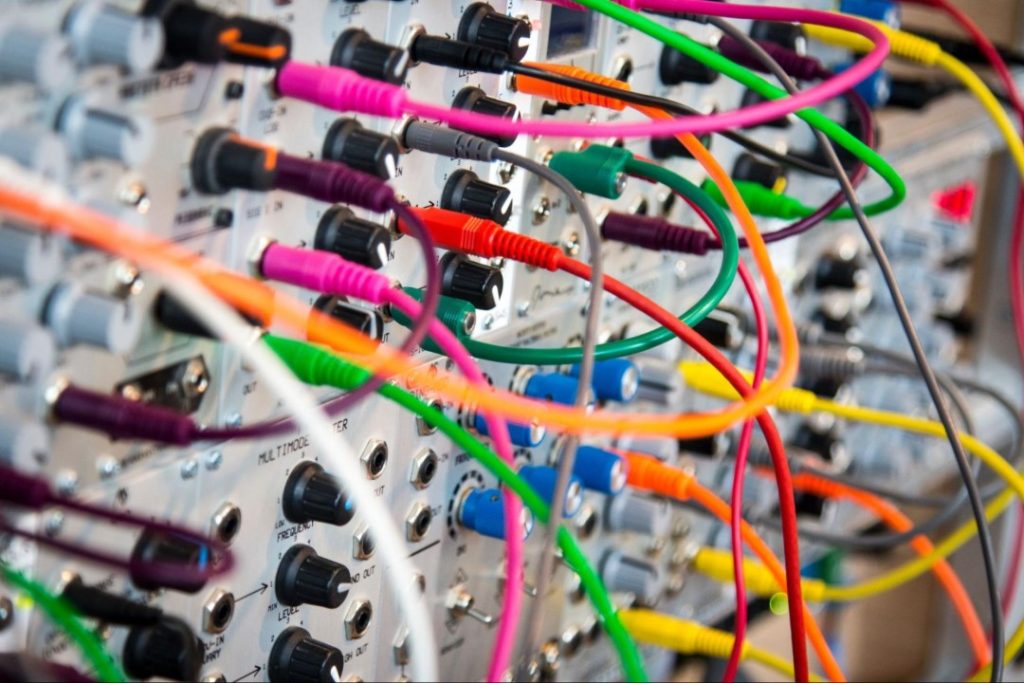All commercial buildings contain wiring on site, and this leads to a lot of cables, especially in a smart building’s data center and around work stations. That’s when a cable tray can become useful. Wire basket cable trays provide a simple and cost-effective cable management solution. However, are wire basket cable trays right for you?
Organized, purple wires
In this article, we will cover:
- What Are Cable Trays?
- Benefits of Cable Trays
- Different Types of Cable Trays
What Are Wire Basket Cable Trays?
Essentially, wire basket cable trays refer to a product specifically designed to keep the wires in a residential or commercial building organized and protected. They support a wide range of different wiring, including power lines, telecommunication wiring, and optical cables. However, you probably need them to organize your data center.
Manufacturers make wire basket cable trays out of aluminum or steel. Aluminum cable trays weigh less and provide anti-corrosive properties. Steel cable trays, on the other hand, can cost less, but it will require more maintenance and can’t protect against corrosion as well.
Related Link: Cabling Solutions Contractor
Benefits of Wire Basket Cable Trays
There are numerous benefits to using cable trays to organize your trays. Some of those benefits include:
- Properly ventilate wires
- Increase space
- Promote organization
- Prevent tripping hazard
- Prevent electrical fire
Cables require adequate ventilation, and they will get that with a wire basket cable tray. The ventilation allows cables to release the heat they generate, and it can reduce the amount of dust that accumulates on the cables.
You also get to increase space by keeping all of your wires together and even keep things more organized. When your workspace is organized, you can do what you need to do, such as unplugging a certain device, more quickly.
Finally, you won’t need to worry about people tripping over cords or damaged cords starting an electrical fire. Electrical fires can occur without proper ventilation or if moisture accumulates around the cables.
Not sure if you need a cable tray or not? Contact C&C Technology Group to learn more about how the right cable tray can increase the organization of your data center and keep your cables in good condition.

Color-coded cables
You may not realize just how many options you have when it comes to cable trays, but there are a large number of designs available. Some of the common cable tray designs include:
- Channel Cable Tray
Channel cable trays work best in situations that don’t provide the best conduit and only need short to medium span up to 10 feet. These trays can fit conveniently on the ground under a desk, but they only offer limited flexibility when it comes to the direction of the cables and can’t support the weight of numerous cables.
- Ladder Type Cable Tray
Ladder type cable trays are the most popular type of cable tray and make up 75% of cable tray usage. They offer long support up to 30 feet of heavy cables, and, when not covered, the heat generated from the wires can disperse into the air instead of causing damage. You also won’t find moisture buildup in ladder type cable trays. The ladder shape allows for a wide range of versatility, perfect for areas when cables don’t always run in the same direction. Most ladder trays space the rungs 9 inches apart, but they can come in 12 or 18-inch spacing as well.
- Solid Bottom Cable Tray
Solid bottom cable trays, like the name suggests, have a solid bottom. They work best for cables that don’t generate too much heat since they don’t offer the same amount of ventilation as some of the alternative options. Moisture can also build up in the trays over time, so it’s important to remove the moisture regularly. However, they provide the best protection for sensitive circuits, especially when the tray is made from metal or fiberglass. It will absorb the shock from sensitive wires and protect them. Solid bottom cable trays offer up to 12 feet of support.
- Wire Mesh Cable Tray
Wire mesh cable trays only provide support for short needs up to 8 feet. They are usually made from steel and coated with zinc, and contain slots on the bottom. They work best for cable management of telecommunications and other low-voltage wires. They can’t support heavy cables, but they do provide an aesthetically pleasing option.
Related Link: Data Center Racks

Tangled cables
Selecting the Right Wire Basket Cable Tray For Your Data Center
When deciding on a cable tray for your data center, you need to take a couple of things into consideration, including the types of wires, the setup of your data center, and the length of support you need. When you know these details, you can pick the cable tray that will keep your data center organized and your cables in good condition for as long as possible.
Types of Wires
Do you need to organize low-voltage or high-voltage wires? What material are the wires made from? How hot do the cables get? Remember that specific cable trays help ventilate the heat while others don’t. Also, you need to consider how many wires you need to manage and how heavy they are.
Related Link: Cat8 Cable: Everything You Need To Know
Data Center Conditions
In your data center, what conditions must you consider? You should think about the risk of moisture and fire as well as ventilation. You also need to consider the conduit properties of the data center to ensure that your wires can transfer data correctly.
Length of Support You Need
Naturally, you also need to consider how much length you need from your cable tray. Particular cable trays provide support for much greater areas than others. Do not only consider how much help you need now but also how that might change in the future.
When C&C Technology Group helps you plan and build your data center, they will also take into consideration the small details, such as the best cable tray for your needs (and your budget). Learn more about their data center services today.
Last Updated on August 2, 2022 by Josh Mahan




